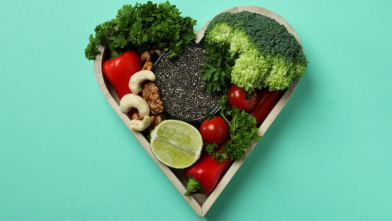How to Portion Control
Viola Holmes, associate director of nutrition of the American Diabetes Association® (ADA), notes that the easiest way to manage meals is the ADA’s Diabetes Plate Method and “good old-fashioned” measuring cups.
“It’s really up to the individual, though, to use a method that works for their lifestyle,” she says.
Let’s explore different options that may work for you and your lifestyle.
Using the Diabetes Plate Method
The Diabetes Plate Method allows you to easily create perfectly portioned meals by balancing vegetables, proteins, and carbohydrates with just a nine-inch plate.
- Fill half the plate with non-starchy vegetables like asparagus, green beans, eggplant, or greens.
- Fill one quarter of the plate with lean proteins, like chicken, salmon, pork loin chops, beans, or tofu.
- Fill the remaining quarter of the plate with healthy carbs like whole grains, starchy vegetables, black beans, fruit, or dairy products.
That’s it! For combination foods, like soups, sandwiches, pasta, or pizza, you can still use the plate method by identifying the different foods and using the same proportions where they would fit the plate. The ADA even has a three-section Portion Control Plate you can use to prepare your meal and transfer to a regular plate or use the lid and take it to-go.
Using Digital Scales
Digital scales can be a great tool as well. You can go for a simple model that is battery-operated and has a backlit display and measuring options (pounds, pounds/ounces, ounces, and grams). Or you can find much more advanced scales that go beyond just weighing food.
Smart scales wirelessly connect to apps on a smart phone. They can do the math for you to help compute daily carb and calorie intake, have nutritional calculators, and track your progress.
Using Portion- and Nutrition-Tracking Apps
For an on-the-go solution, there are apps that can help you track portions and nutrition. Some can also share your data with your health care providers and can integrate with other devices, like your digital scale. Others help you record and manage blood glucose (blood sugar) levels, create shopping lists, and provide nutrition databases.
Picking the Best Tool for You
You’re going to be on this journey for the rest of your life and you must find methods and tools that will engage you enough to stick with it. And it may take a few attempts with different tools to find just the right one(s) that work for you. Just as important, your needs will likely evolve over time, as will the technology. So, if something no longer excites you or keeps you motivated, don’t give up—look for something else!








